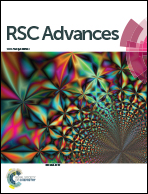Electricity generation, salinity, COD removal and anodic biofilm microbial community vary with different anode CODs in a microbial desalination cell for high-salinity mustard tuber wastewater treatment
Abstract
A three-chamber microbial desalination cell (MDC) was constructed for high-salinity mustard tuber wastewater (MTWW) treatment. The effect of anode COD on electricity generation, salinity, COD removal and the anodic biofilm microbial community in MDC for the MTWW treatment was investigated. The results showed that electricity generation was better when the anode COD was 900 mg L−1 versus when it was 400 or 1400 mg L−1. The ionic strength and conductivity of the anolyte were higher than those at 400 mg L−1; thus, the ohmic internal resistance was lower. In addition, the mass transfer internal resistance was lower than that at 1400 mg L−1, which made the system internal resistance the lowest; consequently, the voltage and power density were the highest. The output voltage, power density and coulombic efficiency of the 1000 Ω external resistors were 555 mV, 3.03 W m−3 and 26.5% ± 0.4%, respectively. Desalination was the highest when the anode COD was 400 mg L−1. The lowest ionic strength and osmotic pressure of the anolyte resulted in the strongest osmosis, thereby producing the highest desalination rate; the desalination rate was 5.33 mg h−1. When MDC was coupled with the dual-chamber microbial fuel cell (MFC), the desalinated MTWW could be used as the anode substrate of the MFC; its high COD could be removed continuously, and the COD removal values were 86.2% ± 2.5%, 83.0% ± 2.0% and 84.3% ± 2.4%. High-throughput sequencing analysis indicated that hydrolytic and fermentative bacteria were the core anode bacteria of MDC. The abundances of electrochemically active bacteria in the anode biofilms of the three groups were 11.78% (400 mg L−1 COD), 14.06% (900 mg L−1 COD) and 13.68% (1400 mg L−1 COD). Therefore, the differences in anode CODs impacted the abundance of electrochemically active bacteria, which led to differences in electricity generation performances.



 Please wait while we load your content...
Please wait while we load your content...